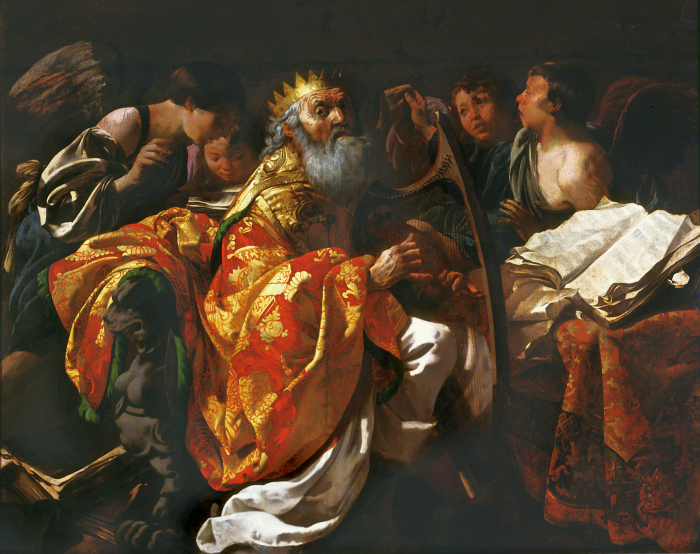‘He Must Reign’: The Kingdom of God in Scripture
Lesson Six: ‘The Key of David’: Church and Kingdom in the New Testament

Lesson Objectives
- To understand the characteristics and identity of the kingdom of God as it is portrayed in the New Testament epistles and the Book of Revelation.
- To see how the Church is identified with the kingdom in the New Testament.
- To understand how the Church, as it is portrayed in the New Testament, bears the characteristics of the Davidic kingdom.
I. Kingdom and Church
A. Review and Overview
In our first five lessons, we’ve explored in a detailed way the Old Testament’s understanding of the kingdom of God and its significance to the overall narrative unity and meaning of the Bible.
We’ve also undertaken a close examination of the gospels of Matthew and Luke, as well as the Book of Acts, in order to consider how the kingdom was understood in the preaching of Jesus and in the proclamation of the apostolic Church.
In this final lesson, we want to look at the kingdom theme as found in the remainder of the New Testament writings.
It’s true that outside of the synoptic gospels and Acts, explicit references to the kingdom of God are sparse. However, it is clear that these New Testament writings share the same presumption that the kingdom proclaimed by Christ is the restoration of the everlasting kingdom promised by God to the son of David (see 2 Samuel 7).
Throughout the New Testament, Jesus himself is designated as the messianic offspring promised to David (see Romans 1:3; Revelation 5:5, 22:16; Sirach 47:2). Hebrews applies a messianic psalm to Christ, identifying Him as David’s anointed son whose kingdom will last forever (see Hebrews 1:8-9; Psalm 45:6-7).
Christ’s resurrection and ascension are described as a heavenly enthronement at God’s right hand. In this, Christ is shown to fulfill the messianic promise of Psalm 110:1 (seeEphesians 1:20; Hebrews 1:13).
He is depicted as ruling from heaven over a restored Davidic kingdom - a kingdom that embraces both Jews and Gentiles (see Ephesians 3:6; 2:18-19).
Christ is said to have dominion and authority over both "those in heaven and on earth" (seePhilippians 2:9-11; Revelation 5:10; 2 Timothy 4:18). Furthermore, his rule is for all ages - "not only in this age but also in the age to come" (see Ephesians 1:20-21; Revelation 1:5; 2 Peter 1:11).
B. The Beloved Son/h5>
The core of Christ’s gospel - the proclamation of the kingdom - underlies the New Testament writings, even if the term "kingdom" itself is only infrequently used. And in these writings, we’re given a richer and fuller understanding of the identity and characteristics of the kingdom.
The kingdom is closely associated and, in a certain way, identified with the Church.
Colossians, for instance, uses language that hearkens back to the exodus to describe the salvation that comes in the Church: "He delivered us from the power of darkness andtransferred us to the kingdom of His beloved Son, in whom we have redemption" (seeColossians 1:13).
This passage introduces Colossians’ great hymn to the beloved Son, who is described as "the head of . . . the Church" (see Colossians 1:18).
Thus, the kingdom of the beloved Son and the Church seem to be very nearly identical in the mind of Paul.
In Ephesians, too, it seems that the terms "Church" and "kingdom" are used almost interchangeably. Jesus is called the head of the Church (see Ephesians 1:22; 5:23) and His dominion is described as "the kingdom of Christ and of God" (see Ephesians 5:5).
Other Lessons
- Lesson One: A Throne Established Forever
- To begin to appreciate the significance of God’s covenant with David for understanding the content and meaning of the New Testament.
- To understand the biblical idea of the monarchy and the Old Testament background for the Davidic covenant.
- To understand the basic outlines of the promises made to David and the shape of the Davidic kingdom under both David and Solomon.
- Lesson Two: Looking for the ‘New David’
- To understand the basic outline of Israel’s history in the centuries between the collapse of the Davidic kingdom and the beginning of the New Testament era.
- To appreciate how the collapse and disappearance of the Davidic Kingdom shaped Israel’s hopes and beliefs in the five centuries before Christ.
- To understand how God’s covenant promises were interpreted by Israel’s prophets and how those prophecies were understood in the last centuries before Christ.
- Lesson Three: The Son of David in Matthew’s Gospel
- To understand the symbolism Matthew uses to convey the truth that Jesus Christ is the perfect Son of David.
- To see how the baptism of Jesus corresponds to the anointing of the Davidic kings.
- To understand how Matthew sees Jesus’ kingdom as the fulfillment of the promises in the prophets.
- Lesson Four: The Throne of David, His Father
- To see how Luke emphasizes Jesus’ lineage as Son of David in the infancy narrative.
- To see how Jesus appears in public as the Son of David throughout Luke’s Gospel.
- To understand how, at the climax of Luke’s Gospel, Jesus takes his place as heir to the kingdom of David.
- Lesson Five: The Spread of the Kingdom in Acts
- To understand how Jesus’ parting words to His disciples form a map of the ideal Davidic kingdom.
- To see how the structure of the Acts of the Apostles follows that map.
- To see how Luke paints the nascent Church as the Davidic kingdom perfectly restored.


